| Marker title
|
English Translation
|
Category
|
Type
|
Description
|
Location
|
Language
|
Date Issued
|
Image
|
Apolinario Mabini
(1854–1903)
|
|
Structure
|
|
Banished to Guam from 1901 with other Filipino political prisoners who are against the American rule.
|
Asan Point, Guam, United States
|
English
|
1964
|

|
Apolinario Mabini
(1854–1903)
|
|
|
|
Banished to Guam from 1901 with other Filipino political prisoners who are against the American rule.
|
Guam, United States
|
English
|
|
|
| The Arrival of Filipino Plantation Workers in Hawaii
|
|
|
|
They arrived on December 20, 1906. They were fifteen who came from Ilocos and the pioneer Filipino migrants in Hawaii.
|
Filipino Community Center, Waipahu, Hawaii, United States
|
English
|
September 16, 2006
|

|
| Dr. Jose Rizal[3]
|
|
|
|
|
Acapulco, Mexico
|
|
January 11, 1998
|
|
| Dr. Jose Rizal
|
|
|
|
Where Rizal studied the local educational system and where he got famous for being an oculist.
|
Hong Kong, China
|
English
|
|
|
| Dr. Jose Rizal
|
|
|
|
Where Rizal began his annotation of Antonio de Morga's Sucesos de las Islas Filipinas.
|
London, United Kingdom
|
English
|
|
|
| Dr. Jose Rizal
|
|
|
|
|
Madrid, Spain
|
Spanish
|
|
|
| Plaque commémorative
|
Here stayed in June 1883 José Rizal (1861-1896), Philippine national hero, writer and doctor. On the occasion of the centenary of his death on December 30, 1896.
|
Building
|
House
|
Ici séjourna en juin 1883 José Rizal (1861-1896), héros national philippin, écrivain médecin. À l'occasion du centenare de sa mort le 30 décembre 1896.
|
37 rue de Maubeuge, 9me arrondissement, Paris, France
|
French
|
December 30, 1996
|

|
| Jose Rizal (1861-1896)
|
Jose Rizal (1861-1896), National Hero of the Philippines, lived in this house in 1889. It was here that he wrote books and articles that stimulated the Filipino national spirit.
|
Building
|
House
|
José Rizal (1861-1896), Héros national des Philippines, vécut dans cette maison en 1889. C'est ici qu'il écrivit des livres et des articles qui stimulèrent l'esprit national philippin.
|
45 rue de Maubeuge, 9me arrondissement, Paris, France
|
French
|
1959
|

|
| Dr. Jose Rizal (1861–1896)
|
|
|
|
National hero of the Philippines, visited Chicago on May 11, 1888.
|
Filipino American Council of Chicago, Chicago, United States
|
English
|
1993
|
|
| Dr. Jose Rizal (1861–1896)[4]
|
|
|
|
National hero of the Philippines, where Rizal stayed in Vienna.
|
Leopold Hof Building, Vienna, Austria
|
German
|
June 19, 1995
|

|
| Dr. Jose Rizal (1861–1896)
|
|
|
|
National hero of the Philippines, where he completed Noli Me Tángere.
|
Jägerstraße, Berlin, Germany
|
German
|
2003
|

|
Embahada ng Pilipinas
Fujimi, Chiyoda-Ku, Tokyo
|
Embassy of the Philippines
Fujimi, Chiyoda-Ku, Tokyo
|
|
|
Declared as a national historical landmark by the NHCP.
|
Chiyoda-ku, Tōkyō, Japan
|
Filipino,
A Japanese translation is provided under
|
March 3, 2014
|
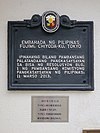
|
Embassy of the Philippines
Tokyo
|
|
Building/Structure
|
Foreign Embassy
|
Building purchased by Jose P. Laurel for the Philippines.
|
Chiyoda-ku, Tōkyō, Japan
|
English
|
March 9, 1962
|

|
| Hommage
|
Tribute
|
|
|
Commemorating the gathering of Filipino intellectuals and patriots who gathered at the studio of Juan Luna.
|
Masson Daniel, 65 Boulevard Arago, Paris, France
|
French
|
1987
|
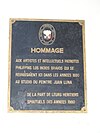
|
| Jose P. Laurel[5]
|
|
|
|
|
Nara, Japan
|
|
March 9, 1969
|
|
| Jose Protacio Rizal
(1861-1896)
|
|
|
|
National Hero of the Philippines. Martyred on December 30, 1896.
|
Columbus Drive, Jersey City, New Jersey[6]
|
English
|
October 24, 2000
|
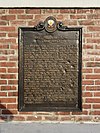
|
| Jose Rizal
|
|
|
|
National Hero of the Philippines. House where he wrote El Filibusterismo.
|
42 Rue Philippe de Champagne, Brussels, Belgium
|
French
|
2007
|

|
| Jose Rizal
|
|
|
|
National hero of the Philippines. The living soul of the Philippine Revolution.
|
Rosemeadow, Campbelltown, New South Wales, Australia
|
English
|
October 26, 2012
|

|
| Jose Rizal
|
|
|
|
National Hero of the Philippines. Martyred on December 30, 1896.
|
Cherry Hill, New Jersey, USA
|
English
|
November 17, 2018
|
|
| Jose Rizal (1861–1896)[3]
|
|
|
|
|
Brussels, Belgium
|
|
June 12, 1998
|
|
| Jose Rizal (1861–1896)[3]
|
|
|
|
|
Brasilia, Brazil
|
|
June 12, 1998
|
|
| Jose Rizal (1861–1896)[3]
|
|
|
|
|
Havana, Cuba
|
|
June 12, 1998
|
|
| Jose Rizal (1861–1896)[3]
|
|
|
|
|
Madrid, Spain
|
|
June 12, 1998
|
|
| Jose Rizal (1861–1896)[3]
|
|
|
|
|
Ottawa, Canada
|
|
June 12, 1998
|
|
| Jose Rizal (1861–1896)[3]
|
|
|
|
|
Port Moresby, Papua New Guinea
|
|
June 12, 1998
|
|
| Jose Rizal (1861–1896)[3]
|
|
|
|
|
Stockholm, Sweden
|
|
June 12, 1998
|
|
| Jose Rizal (1861–1896)[3]
|
|
|
|
|
Riyadh, Saudi Arabia
|
|
June 12, 1998
|
|
| Jose Rizal (1861–1896)[3]
|
|
|
|
|
Roppongi, Tōkyō, Japan
|
|
June 12, 1998
|
|
| Jose Rizal (1861–1896)[3]
|
|
|
|
|
Vatican
|
|
June 12, 1998
|
|
| Jose Rizal
(1861–1896)
|
|
|
|
National hero of the Philippines.
|
Carson International Sculpture Garden, 801 E. Carson Street, Carson, California, United States[7]
|
English
|
September 29, 2012
|
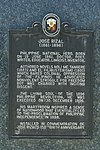
|
| Jose Rizal
(1861–1896)
|
|
|
|
National hero of the Philippines.
|
Nose Creek Regional Park, Airdrie, Alberta, Canada
|
English
|
June 19, 2022[8]
|

|
| Jose Rizal (1861-1896)
|
|
Personages
|
Biographical marker
|
National hero of the Philippines.
|
Earl Bales Park, Toronto, Ontario, Canada
|
English
|
June 22, 2022
|

|
| Jose Rizal 1861-1896
|
|
|
|
National hero of the Philippines.
|
Rizal Monument, Cooper River Park, Camden County, Cherry Hill, New Jersey, USA
|
English
|
November 17, 2023[9]
|
|
| José Rizal 1861–1896[10]
|
|
|
|
National hero of the Philippines, marking the house where Rizal wrote the final parts of Noli Me Tángere.
|
Wilhelmsfeld, Germany
|
German
|
January 4, 1960
|
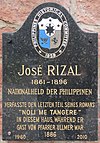
|
| José Rizal 1861–1896[11]
|
|
|
|
National hero of the Philippines, ophthalmology clinic of Rizal in Paris.
|
124 rue de Rennes, 6th arrondissement, Paris, France
|
French
|
1959
|

|
| José Rizal
1861–1896
|
|
|
|
National hero of the Philippines, where Rizal lived when he published the Fili.
|
Henegouwenstraat 9, Ghent, Belgium
|
French
|
1959
|

|
| Lumang Chancery ng Pasuguan ng Republika ng Pilipinas sa Estados Unidos
|
Old Chancery of the Embassy of the Republic of the Philippines in the United States
|
|
|
Built under the designs of Appleton Prentis Clark, Jr. Bought by the Philippine Commonwealth through the efforts of Joaquin Elizalde from 1941 to 1946.
|
Old Philippine Embassy Chancery, 1617 Massachusetts Avenue NW Washington DC, United States
|
Filipino, English
|
November 9, 2018
|

|
| Paduka Batara
|
|
|
|
King of Sulu who died in Dezhou. He travelled to China in 1417 to pay tribute to Emperor Yongle.
|
Dezhou, China
|
English
|
May 23, 1999
|
|
| Philippine Ambassador's Residence in the United States
|
|
Buildings/
Structures
|
House
|
Built by William Lipscomb for General and Charles and Emma Fitzhugh.
|
2253 R Street Northwest, Washington D.C., United States
|
English
|
June 13, 2022[12]
|
|
| The Philippine National Flag
|
|
|
|
Where the first flag was sewn by Marcela Mariño Agoncillo and her companions Lorenza Agoncillo and Delfina Herbosa Natividad. First hoisted during the Battle of Alapan.
|
Morrison Hill, Hong Kong, China
|
|
May 28, 1998[3]
|
|
| Sewing of the First National Flag[3]
|
|
|
|
|
Hong Kong, China
|
|
1998
|
|



















